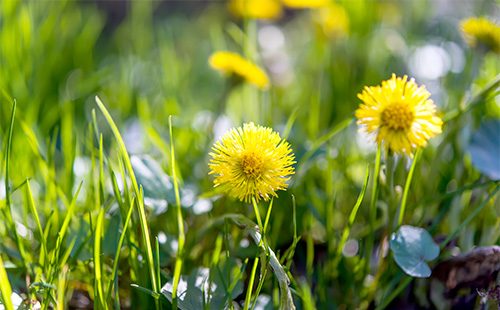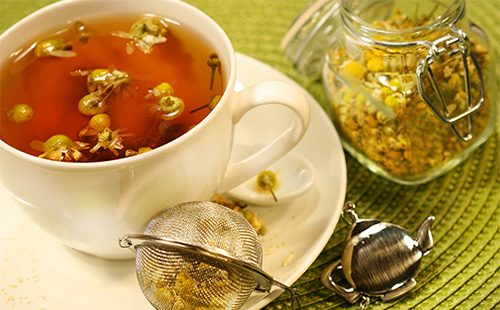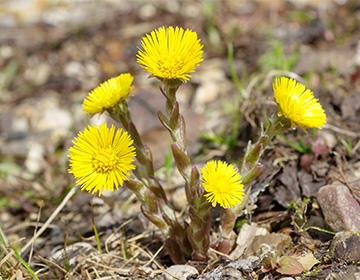The content of the article
The main medicinal raw materials are plant leaves. Their pharmacological properties are scientifically confirmed. Herbal remedies are widely used in traditional medicine, adding to various antitussive fees. In the folk, other parts are also used - flowers with young shoots, rhizomes.
Botanical characteristic
Another name - a runnik - was given to the plant for unusually early flowering. The first flowers appear in the second half of March, and the grass continues to bloom until April. Prefers moderate climatic conditions. Very common on the European continent. It is found everywhere in the European part of Russia, as well as in the Caucasus Mountains. Modest natural reserves are also present in Siberia. Also, the plant is common in Central and Asia Minor, therefore it is often used in oriental medicine.
To find coltsfoot, you should take a walk along the valleys of rivers and lakes, moist beams, well-moistened slopes. For successful growth, the culture needs not only sufficiently moist, but also well-drained soil. It develops best on sandy and clay soils.
The plant is characterized by the following morphological characteristics.
- Underground part. It is represented by a thickened, creeping, branched rhizome, from which numerous subordinate roots and ascending shoots depart. It is in the underground part that nutrients are stored that provide earlier flowering.
- Shoots. They are peduncles, not branched. They rarely exceed 20 cm in length. Covered with the first modified lamellar leaves of green-brown hue.
- Leaves. They begin to develop after flowering. Large, fleshy, at the beginning of development densely white-felt on both sides. The structure is dense, the shape is wide-hearted, the edge is coarse. As it develops, the upper part becomes bare, acquires a light green color, provides the plant with evaporation of excess moisture, therefore it is always cool to the touch. The underside remains soft and white-felt. Leaves become ripe (bare from above) by the end of May.
- Flowers. Like other representatives of the Astrov family, they are collected in baskets. The wrapper is two-layer. Reed flowers are placed along the edge of the basket, and tubular in the middle. The color of the inflorescences is rich yellow. When flowering, the plant exudes a pleasant honey aroma.
- Fruit. They are represented by cylindrical achenes with a hairy tuft on top.
Harvesting raw materials
You can start collecting three weeks after the baskets have faded. To maintain the interval is necessary for the successful maturation and distribution of plant seeds. So the view is preserved.
- Collection. Well-developed basal leaves are torn off by hands or cut off with secateurs, leaving half the petiole on the plant. In this case, the lower part must be held so as not to damage the root system.
- Training. Sort large leaves for damaged or damaged parts by pests.If there are any, they remove the whole sheet. The raw materials are laid out in a thin layer on a pallet covered with cloth or paper.
- Drying. Pallets are placed in a shaded, well-ventilated place. Canopies with through passage of air are ideally suited. You can use the dryer, observing a temperature of up to 60 ° C.
- Storage. Completely dried leaves are crushed or whole are packed in dense linen bags. Save in a dark and dry place for three years.
For use according to popular recipes, flowers are harvested in early spring. Closed baskets and peduncles are subject to collection. The dried raw materials are ground and mixed well.
Rhizomes are harvested before flowering or in late autumn, when basal leaves die off.
Composition
It is scientifically proven that the concentration of nutrients is higher in those leaves of the plant that developed under open sunlight.
- Polysaccharides. In particular, dextrins and inulin. These substances normalize metabolic processes, have an enveloping, protective effect, and also contribute to the improvement of intestinal motility. Inulin removes toxins from the body, normalizes lipid and carbohydrate metabolism.
- Essential oil. Due to the volatile components, the plant has bacteriostatic, anti-inflammatory and regenerative effects.
- Slime. Provide enveloping and protective effects of plant materials, soften mucous membranes, stimulate sputum liquefaction.
- Tannins. They have astringent and anti-inflammatory, as well as weak antimicrobial effects. Stimulate blood formation, regulate blood viscosity, normalize the immune system.
- Saponins. They activate the secretory activity of the digestive tract, optimize the synthesis and excretion of bile, reflexively stimulate sputum discharge, helping to cleanse the lungs.
- Organic acids. Among them - wine, gall, apple and ascorbic. They have a general strengthening, immunostimulating, antimicrobial and secretory action. They improve metabolism, eliminate intoxication.
- Glycosides. High concentrations of tussilagin, a bitter glycoside that stimulates appetite, has a sedative effect on the nervous system, and relieves smooth muscle spasms, were revealed.
- Phytosterols. Plant substances that can prevent and stop the development of atherosclerosis, normalize lipid metabolism and cleanse the body of excess lipid-containing compounds.
- Flavonoids. They have an immunostimulating, vasoprotective, antioxidant effect. Provide normal blood pressure, stimulate regenerative processes, improve blood circulation and trophic peripheral tissues.

Healing properties
Official medicine uses cough herb. Herbal medicine helps with:
- pneumonia;
- bronchitis;
- whooping cough;
- lung abscess;
- tuberculosis.
Raw materials liquefies sputum, demonstrates anti-inflammatory and antimicrobial effects, therefore it is used to prevent complications of colds and flu. The enveloping and softening effects are relevant for irritation of the mucous membranes during dry cough, as well as for their infectious and inflammatory lesions: tracheitis, laryngitis, hoarseness. Also, the raw material lowers the temperature, eliminates chills and body aches.
Given a wide range of pharmacological properties, herbalists recommend coltsfoot leaves for other purposes.
- Gastrointestinal tract. Raw materials improve digestion, stimulate the formation of bile.It is prescribed for gastritis, inflammation of the intestine, with infectious diarrhea. Helps relieve symptoms of irritable bowel and hemorrhoids.
- The kidneys. By including coltsfoot in kidney collections, their effect can be strengthened and at the same time mitigated. The grass stimulates the formation of urine, helps to eliminate excess fluid, normalizes lymphatic flow, helps get rid of edema of any localization and even ascites.
- CNS. It has a mild sedative effect. Helps with anxiety and insomnia. Regulates biorhythms, makes night sleep more productive. Used for epilepsy and a tendency to cramps.
- Heart and blood vessels. Regulates vascular tone, relieves spasms of blood vessels and migraines provoked by them. Improves trophism and myocardial function, allows you to cleanse blood of cholesterol. By regulating lipid metabolism, it cures and prevents atherosclerosis, and also strengthens the vascular walls, which protects against stroke.
- Metabolism. As a source of inulin and organic acids, it can be used to regulate blood sugar. Prevents hunger attacks triggered by insulin surges. It optimizes fat and electrolyte metabolism, improves the absorption of vitamins and cleanses the body of toxins. This allows you to use raw materials as an aid in losing weight.
- Leather. Extracts from a plant heal damage, prevent the formation of pus, and cleanse wounds of necrotic masses. Hoods are used to rinse the mouth, throat, rinse wounds, as well as lotions and compresses. The latter options are relevant for boils, trophic ulcers and bedsores, eczema and seborrhea. Phytomedicine is also recommended for joint pain, inflammation of varicose veins.
Contraindications
The grass has contraindications - violations in the liver and kidneys, individual sensitivity. Also, if the dosages are exceeded and the recommended duration of the course of treatment (should be no more than a month), the development of side effects is not ruled out. In addition, there are categories of patients who should be especially careful about the plant.
- Women. They can use herbal medicine only if the menstrual cycle is stable. In this case, the internal intake of grass extracts is prohibited for pregnant women (due to the risk of an abortive effect) and during lactation (due to the glycoside composition). But doing lotions on wounds or gargling is permissible.
- Children. Grass should not be given to children under two years of age. In some sources, this ban is extended to six years. In practice, the pediatrician may advise weak extracts, even to infants, if other drugs cannot be used for some reason.
Prescription Drugs
The pharmacy sells herbal teas, syrups, dietary supplements, which include mother-and-stepmother. Available and dried raw materials, from which you can make homemade medicines.
Decoction
Features The remedy is relevant for colds and digestive disorders. It contains a moderate amount of biologically active substances, therefore it acts gently.
Preparation and use
- A tablespoon of the raw material is placed in a container suitable for heating in a water bath.
- Pour a glass of boiling water.
- Immediately put the container in a boiling bath, heat it for a couple of minutes.
- Remove the hood from the fire, leave to infuse for half an hour.
- After straining, take half a glass inside three times a day.
Infusion
Features Suitable for eliminating the acute symptoms of ailments. Can be used externally.
Preparation and use
- Two tablespoons of raw materials are placed in a thermos.
- Pour a glass of boiling water.
- Leave for a couple of hours.
- After filtering, take three tablespoons three times a day.
Milk extract
Features It is suitable for acute inflammatory processes of the upper and lower respiratory tract, as well as for hoarseness of the voice, angry dry cough.
Preparation and use
- A spoonful of raw material is poured into a glass of boiled milk.
- Cover, leave for an hour.
- After straining, take orally in a warm form in small sips. Dosage - 1/4 cup four times a day.
Camping
Coltsfoot can be used even in field conditions. To do this, you need to take dry leaves with you or in nature to find thickets of plants.
- Nourishment of the body. Grinding the leaves into a salad, you can "recharge" with vitamins and minerals, energy, and also protect yourself from digestive upsets.
- Elimination of cough. Fresh leaves are crushed and juice is extracted from them. It is stirred with honey or water 1: 1, take up to three tablespoons per day with bouts of coughing, tuberculosis, symptoms of a cold.
- The treatment of the common cold. By instilling diluted juice in the nose, you can not only get rid of congestion, but also cure a runny nose.
- For wound healing. Fresh mashed leaves apply juicy side to skin lesions - this speeds up healing.
- For joint pain. With bruises, dislocations, sprains, joint pains, the sheet should be wound with the warm side to the skin - this will improve blood circulation and relieve pain.
Dried leaf powder is also a valuable tool in a travel medicine cabinet. Taking it in half a teaspoon and drinking it with water, you can get rid of cough. Also drink with diarrhea and for its prevention. If you dilute the powder into gruel - you get a compress on the inflamed joints. The product is sprinkled with wounds, burns, frostbite, abscesses - this eliminates the secretion of exudate, disinfects, accelerates healing.

Reviews
Just started, it’s too early to talk about the results, because we cough for the second week and it has already started to pass, my elder is sick every month, he is younger and I, if I constantly give medications, we’re not afraid of immunity, my mother always advised about herbs, I waved off somehow, now I decided I read about them, I scooped up a bunch of sites, came to the conclusion that they are better than all medicines, the main thing is to correctly approach this matter and not go too far, in general, while we drink mother and stepmother, I give honey and inhalations with saline
Katya-Katerina, https://www.babyblog.ru/community/post/diseases/1705452
Coltsfoot, the name of this herb is always heard when it comes to relieving cough. But I still have not considered it as a method of treatment, I usually recognized more expensive syrups and pills. But this time, when my old bronchitis erupted after the flu, I bought a pack of coltsfoot, for the sake of the experiment. He succeeded and made me regret the money spent on expensive drugs.
Narisha http://irecommend.ru/content/vylechila-bronkhit-za-sushchie-kopeiki
This plant has been familiar to me since childhood. Considers a universal folk remedy. Outwardly, in the form of gruel, fresh leaves are used in the treatment of tumors, boils, abscesses. It also helps with headaches: fresh leaves are applied to the head with a smooth side.
An infusion or decoction of the leaves is used for coughing, suffocation, dropsy, scrofula, and freshly squeezed juice from the leaves and roots for tuberculosis, as a choleretic and diaphoretic (1 tablespoon 3 times a day)
For inflammation of the bladder and stomach disease, kidney diseases, an infusion or broth is used (15 g is 3 tablespoons of dried mother and stepmother is filled with 200 g of water, taken in a tablespoon every 2 to 3 hours.
KATERINA55555, http://irecommend.ru/content/universalnoe-sredstvo-protiv-vsekh-khvorei

